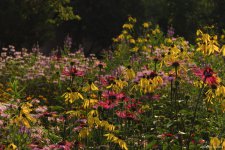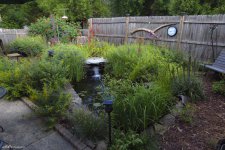Overview
Welcome to my pond!

In 2014, I designed and built my 800 gallon pond after 4 years of having smaller ponds. I added the pond and its surrounding garden spaces in an attempt to attract more wildlife to my yard. In addition to the pond, I added a bog filter, which would double as additional wetland habitat. In 2018, I expanded the garden area to nearly double the previous size, now including a rain garden, a shade garden, and some additional garden space. You can see my layout in the graphic below.

I originally built a pond in hopes of attracting frogs to my yard. While frogs did quickly appear, I also learned that the pond would attract a lot more. Birds fly in often to drink and bathe in my bog, and I've even had Mallard Ducks nest next to my pond. Dragonflies have also become a common sight. When I added native plants, I started seeing even more wildlife. Butterflies of a dozen or more species can be seen near my pond throughout summer, and hummingbirds are also frequent visitors now that I've added some of their favorite nectar sources, including Cardinal Flower and Great Blue Lobelia, which grow both in my bog and in my rain garden.




While the project was originally focused on attracting wildlife, the focus has shifted toward helping wildlife. While that might sound like the same thing, attracting wildlife was more about me than it was about the them. I wanted to see them for my own personal benefit. Now, my focus is heavily on providing for wildlife and giving them a place to reliably find food, shelter, and nesting material. I've learned a lot about native plants over the past seven years, and I've used what I've learned to plant some of the best possible species to help wildlife in my area, starting with multiple species of Milkweed to help Monarch butterflies, but also planting a wide variety of other host plants and nectar plants.



Here are some more photos taken around my pond:








Beyond the pond, I've also added about 1200 sq. ft. of native garden habitat in other parts of my yard that includes more than 35 native plant species, and ten nesting boxes that have been used by Tree Swallows, Black-capped Chickadees, and House Wrens. Many butterfly species can be seen drinking nectar or laying eggs on host plants. Bees of all sorts can be seen going from flower to flower drinking nectar and collecting pollen, or laying eggs in hollow stems. Frogs and toads can be seen on the ground looking for their next meal. While my pond has been a lot of fun, the native gardens are what I'm most proud of. It's truly a miniature habitat restoration that is desperately needed for so many species.

In 2014, I designed and built my 800 gallon pond after 4 years of having smaller ponds. I added the pond and its surrounding garden spaces in an attempt to attract more wildlife to my yard. In addition to the pond, I added a bog filter, which would double as additional wetland habitat. In 2018, I expanded the garden area to nearly double the previous size, now including a rain garden, a shade garden, and some additional garden space. You can see my layout in the graphic below.
I originally built a pond in hopes of attracting frogs to my yard. While frogs did quickly appear, I also learned that the pond would attract a lot more. Birds fly in often to drink and bathe in my bog, and I've even had Mallard Ducks nest next to my pond. Dragonflies have also become a common sight. When I added native plants, I started seeing even more wildlife. Butterflies of a dozen or more species can be seen near my pond throughout summer, and hummingbirds are also frequent visitors now that I've added some of their favorite nectar sources, including Cardinal Flower and Great Blue Lobelia, which grow both in my bog and in my rain garden.
While the project was originally focused on attracting wildlife, the focus has shifted toward helping wildlife. While that might sound like the same thing, attracting wildlife was more about me than it was about the them. I wanted to see them for my own personal benefit. Now, my focus is heavily on providing for wildlife and giving them a place to reliably find food, shelter, and nesting material. I've learned a lot about native plants over the past seven years, and I've used what I've learned to plant some of the best possible species to help wildlife in my area, starting with multiple species of Milkweed to help Monarch butterflies, but also planting a wide variety of other host plants and nectar plants.
Here are some more photos taken around my pond:
Beyond the pond, I've also added about 1200 sq. ft. of native garden habitat in other parts of my yard that includes more than 35 native plant species, and ten nesting boxes that have been used by Tree Swallows, Black-capped Chickadees, and House Wrens. Many butterfly species can be seen drinking nectar or laying eggs on host plants. Bees of all sorts can be seen going from flower to flower drinking nectar and collecting pollen, or laying eggs in hollow stems. Frogs and toads can be seen on the ground looking for their next meal. While my pond has been a lot of fun, the native gardens are what I'm most proud of. It's truly a miniature habitat restoration that is desperately needed for so many species.
Fish / Plant Stock
Here's a frequently updated list of all of the plants in or around my pond, as well as a list of the most common wildlife seen in or around the pond.
PLANTS:
(All North American native species are linked to their profile on the Missouri Botanical garden's website, so you can learn more about the native species I grow.)
(In the pond)
- Bog Bean (Menyanthes trifoliata)
- Blue Arrows Rush (Juncus inflexus)
- Blue Flag Iris (Iris virginica var. shrevei)
- Broad-leaved Arrowhead (Sagittaria latifolia)
- Hardy Water Lilies (Nymphaea)
- Horsetail Rush (Equisetum hyemale)
- Smooth Black Sedge (Carex nigra)
(In the bog)
- Blue-Eyed Grass (Sisyrinchium angustifolium)
- Blue Flag Iris (Iris virginica var. shrevei)
- Cardinal Flower (Lobelia cardinalis)
- Great Blue Lobelia (Lobelia siphilitica)
- Golden Queen Globeflower (Trollius chinensis)
- Horsetail Rush (Equisetum hyemale)
- Marsh Marigold (Caltha palustris)
- Sensitive Fern (Onoclea sensibilis)
- Spiderwort (Tradescantia ohiensis)
(In the surrounding garden spaces)
- Blanket Flower (Gaillardia X grandiflora)
- Blue Grama (Bouteloua gracilis)
- Blue Giant Hyssop (Agastache foeniculum)
- Bush's Coneflower (Echinacea paradoxa)
- Cardinal Flower (Lobelia cardinalis)
- Dianthus (Dianthus deltoides "Arctic Fire")
- Eastern Red Columbine (Aquilegia canadensis)
- Ferns (Wood Fern, Lady In Red Fern)
- Foxglove Beardtongue (Penstemon digitalis 'Husker's Red')
- Great Blue Lobelia (Lobelia siphilitica)
- Hoary Vervain (Verbena stricta)
- Indian Pink (Spigelia marilandica)
- Joe Pye Weed (Eutrochium purpureum)
- Kalm's St. John's Wort (Hypericum kalmianum)
- Marsh Blazing Star (Liatris spicata)
- Meadow Blazing Star (Liatris ligulistylis)
- Mexican Sunflower (Tithonia rotundifolia "Torch")
- Nodding Onion (Allium cernuum)
- Orange Milkweed (Asclepias tuberosa)
- Partridge Pea (Chamaecrista fasciculata)
- Prairie Coreopsis (Coreopsis palmata)
- Prairie Smoke (Geum triflorum)
- Purple Poppy Mallow (Callirhoe involucrata)
- Rocky Mountain Penstemon (Penstemon strictus)
- Royal Catchfly (Silene regia)
- Side Oats Grama (Bouteloua curtipendula)
- Spiderwort (Tradescantia ohiensis)
- Stout Blue Eyed Grass (Sisyrinchium angustifolium)
- Wild Geranium (Geranium maculatum)
COMMON WILDLIFE:
- American Goldfinches
- American Robins
- American Toads
- Bees (various species)
- Black-capped Chickadees
- Butterflies (various species)
- Bullfrogs
- Damselflies (various species)
- Downy Woodpeckers
- Dragonflies (various species)
- Eastern Chipmunks
- Eastern Gray Squirrels
- Green Frogs
- House Finches
- House Wrens
- Ruby-throated Hummingbirds
- Mallard Ducks
- Mourning Doves
- Northern Orioles
- Wood Thrushes
...and Goldfish (non-native)
PLANTS:
(All North American native species are linked to their profile on the Missouri Botanical garden's website, so you can learn more about the native species I grow.)
(In the pond)
- Bog Bean (Menyanthes trifoliata)
- Blue Arrows Rush (Juncus inflexus)
- Blue Flag Iris (Iris virginica var. shrevei)
- Broad-leaved Arrowhead (Sagittaria latifolia)
- Hardy Water Lilies (Nymphaea)
- Horsetail Rush (Equisetum hyemale)
- Smooth Black Sedge (Carex nigra)
(In the bog)
- Blue-Eyed Grass (Sisyrinchium angustifolium)
- Blue Flag Iris (Iris virginica var. shrevei)
- Cardinal Flower (Lobelia cardinalis)
- Great Blue Lobelia (Lobelia siphilitica)
- Golden Queen Globeflower (Trollius chinensis)
- Horsetail Rush (Equisetum hyemale)
- Marsh Marigold (Caltha palustris)
- Sensitive Fern (Onoclea sensibilis)
- Spiderwort (Tradescantia ohiensis)
(In the surrounding garden spaces)
- Blanket Flower (Gaillardia X grandiflora)
- Blue Grama (Bouteloua gracilis)
- Blue Giant Hyssop (Agastache foeniculum)
- Bush's Coneflower (Echinacea paradoxa)
- Cardinal Flower (Lobelia cardinalis)
- Dianthus (Dianthus deltoides "Arctic Fire")
- Eastern Red Columbine (Aquilegia canadensis)
- Ferns (Wood Fern, Lady In Red Fern)
- Foxglove Beardtongue (Penstemon digitalis 'Husker's Red')
- Great Blue Lobelia (Lobelia siphilitica)
- Hoary Vervain (Verbena stricta)
- Indian Pink (Spigelia marilandica)
- Joe Pye Weed (Eutrochium purpureum)
- Kalm's St. John's Wort (Hypericum kalmianum)
- Marsh Blazing Star (Liatris spicata)
- Meadow Blazing Star (Liatris ligulistylis)
- Mexican Sunflower (Tithonia rotundifolia "Torch")
- Nodding Onion (Allium cernuum)
- Orange Milkweed (Asclepias tuberosa)
- Partridge Pea (Chamaecrista fasciculata)
- Prairie Coreopsis (Coreopsis palmata)
- Prairie Smoke (Geum triflorum)
- Purple Poppy Mallow (Callirhoe involucrata)
- Rocky Mountain Penstemon (Penstemon strictus)
- Royal Catchfly (Silene regia)
- Side Oats Grama (Bouteloua curtipendula)
- Spiderwort (Tradescantia ohiensis)
- Stout Blue Eyed Grass (Sisyrinchium angustifolium)
- Wild Geranium (Geranium maculatum)
COMMON WILDLIFE:
- American Goldfinches
- American Robins
- American Toads
- Bees (various species)
- Black-capped Chickadees
- Butterflies (various species)
- Bullfrogs
- Damselflies (various species)
- Downy Woodpeckers
- Dragonflies (various species)
- Eastern Chipmunks
- Eastern Gray Squirrels
- Green Frogs
- House Finches
- House Wrens
- Ruby-throated Hummingbirds
- Mallard Ducks
- Mourning Doves
- Northern Orioles
- Wood Thrushes
...and Goldfish (non-native)

















